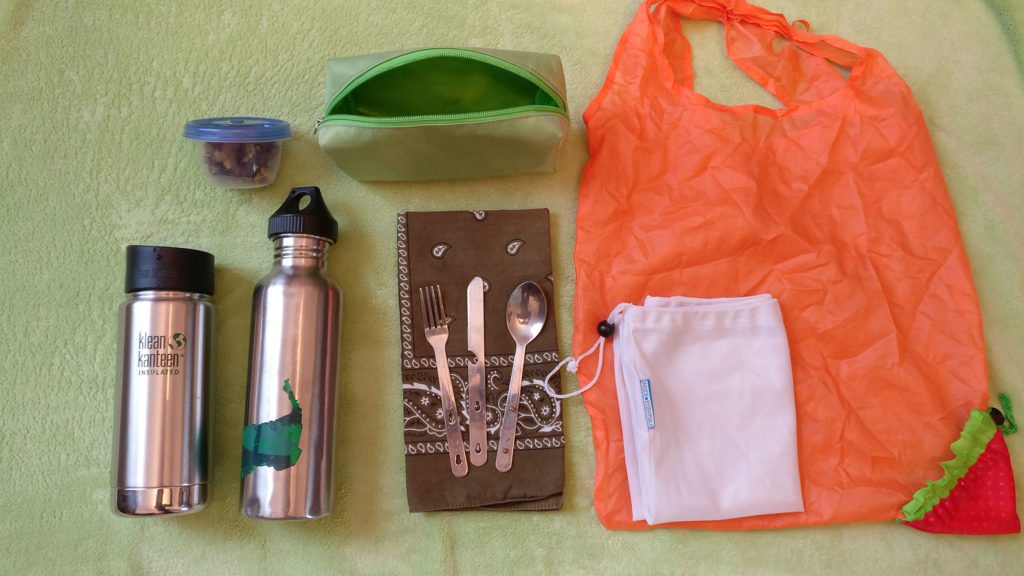Simple Sustainability: 5Rs to Zero Waste
by Sky Trombly –
You’ve probably heard of the three Rs: Reduce, Reuse, Recycle. While the chasing arrow symbol is meant to underscore the equality between these, recycling is the process that everyone seems to remember. Here, we’ll explore why recycling should be pushed down a few pegs if we want to be more environmentally responsible with our waste.
Béa Johnson, author of the Zero Waste Home, and one of the major thinkers behind the Zero Waste movement, places recycling near the bottom of her waste stream hierarchy. Throwing less away in landfills isn’t about recycling more, but about employing a better articulated method of “precycling”, which she expresses in her 5 Rs.
What is “Precycling”?
Well, remember those “reduce” and “reuse” methods that are often ignored? They return here. Precycling is about bringing home products only after considering what their (and their packaging) end life will be like.
Consider whether an item will go to …
− Recycling center? How many times?
− Landfill?
− Litter?
− Compost?
− Polluting our environment?
− Poisoning other countries?
And also:
− How long will it last? Is it single-use? Will it be used a month from now?
Precycling means thinking about the ultimate destination and making the best choice available to us.
For example, you may be aware that plastic is toxic to produce and very hard to recycle. So if you’re at the grocery store and are buying pasta sauce, a good precycling choice would be to buy the glass container with the metal lid instead of the pasta sauce in plastic.
The concept of “precycling” may seem daunting, but the 5Rs provide a systematic approach to make considerations easier.
Bea’s 5 Rs
Her list goes something like this:
1. Refuse what you do not need.
2. Reduce what you do need.
3. Reuse what you have (and buy used).
4. Recycle what you can.
5. Rot the rest.
If you make your decisions in this order, you’ll have very little left to find a good resting place for.
But what do these statements mean?

Refusing what you do not need could mean anything from asking for no straw at a restaurant to deciding that the community pool is a better option than maintaining your own. It is considering what actually brings value to your life and what is the unnecessary surplus that will likely just lead to trash.
What is necessary for you will be different from my necessities so there is no hard list to follow. It is more about checking in with yourself to separate the necessary from the superfluous.
There are a few things that you can do to set yourself up for refusal success. For example, if you bring a canvas tote from home, you can refuse the plastic bag at check out.
Reducing what you do need means stretching what you have so that you’re not buying so frequently. It might mean using less shampoo or developing a capsule wardrobe or using scrap paper when a new sheet isn’t important. Here to, the mindset is what is important. There is no magic list for everything you can reduce.
Reuse what you have (also buy used) probably doesn’t need much explaining. If something you already own can fill a purpose, try that first. The last glass from a set your kids have broken can make a great toothbrush holder. My husband uses my hair dryer way more often than I do – and not for his hair!
We buy as much as we can second-hand and are happy to accept hand-me-downs. It is amazing the kind of money you can save here.
Recycle what you can also doesn’t need much elaboration. However, I will say that what you can recycle will vary from community to community. It is important to know what is actually getting sent to recycling facilities and what is being tossed. Outside of curbside recycling, there are other options. Many grocery stores accept plastic grocery sacks, for example.
Also, as I mentioned above, some materials recycle better than others so choose glass and metal over plastic as much as you can.
Rot the rest refers to composting. It’s easier than you might think and you can compost more than table scraps. I compost our hair and fingernails (from the bathroom) and the contents of the vacuum cleaner’s canister too.
My Take on The 5 Rs
I am in love with this hierarchy of decision making and have little to add. However, I have 2 Rs that are appropriate for my circumstances.
The first is: “Repair what you can”, which just means repairing what your ability and resources will allow. I resew buttons, for example, but I no longer spend the time patching toddler pants. It just isn’t worth it for me. I would place Repair after Reuse on Béa’s list.
The second is: “Roast” which just means “burn what is appropriate”. We rarely have a burn ban in our moist climate. While there are people who irresponsibly burn toxic garbage, I am talking about things like paper, untreated lumber, broken wooden kitchen spoons and bamboo toothbrushes. The sort of thing that is compostable but may take a long time to break down in a home composting system.
I would place this R before Rot, though I’m likely to take paper out of the recycling bin to get our fire pit going.
Your Thoughts
How about you? Have you heard of precycling before? Does the strategy of the 5 Rs seem to be effective against creating waste? What do you think of my additions?
Until next time, be the light by living lightly!

Blog – talkwalking.org
Sky has been something of a sustainability nerd for most of her life. Her goal is to empower herself and others to live in a way that is congruent with personal values – and intimately linked to the Earth. You can join her in her wanderings through the quagmire of sustainable living in every issue of Owl Light News, and on her blog – talkwalking.org